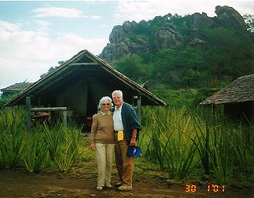
The eldest fellow participants of the safari standing in front of their tent-for-a-night on a foggy morning |
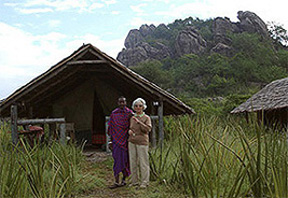
A Masai camp's attendant arrived to call us for breakfast and to collect our luggage |
From Serengeti's Plains back to Mombasa (Part 2/2)
SERENGETI NATIONAL PARK - After troubles are over at last!
The stillness and birds chirping waked me up after 7h and a rainbow appeared at the East. Camp TAWISA close to NDUTU lodge a located between lakes Ndutu and Masek that not far away of Olduvai Gorge either. The camp tents were placed in a row at the foot of a large KOPJE (an igneous rock outcrop, mostly basalt) viewing onto a wide plain and meadow. On top of each tent there was a thatched roof of woven leaves at a gap of some 15 cm thus giving a perfect isolation effect by free moving air in between. Tent wings in front and rears had zips that closed it properly against any kind of inquisitive "dudus" but one had to zip the canvas floor to the wings too. Behind the tent was one canvassed compartment for a dry WC with a bucket of water standing by and the other contained a shower - both were open towards the sky. There wasn't warm water in shower's barrel that one had to pull up so one could "enjoy" a shower under open sky.
At the covered verandah in tent front I found an antique
wash dish and jug, soap and towel allowing a minimum of morning toilette
but I skipped the shaving. Most of camp's staffs were from the Masai tribe
living in this area. Suddenly a Masai appeared from nowhere bringing good
news about breakfast being served and we should pack our belongings leaving
the luggage at verandah. The dinning room was an open area with wooden
board floor and thatched roof from that one had a perfect view on Serengeti's
plains. The sun came out and the morning haze disappeared gradually and
grazing herds came in view soon. French managers were to leave with a few
of their guests so wishing us the best safari afterwards. They offered
us to use the camp's facilities until SIMBA cars would come to pick us
up at time still unknown. After a breakfast the stranded fellow passengers
choose to stay in the dining room's shadow enjoying light breeze exchanging
experiences of the previous day.

The eldest fellow participants of the safari standing in front of their tent-for-a-night on a foggy morning |

A Masai camp's attendant arrived to call us for breakfast and to collect our luggage |
I went inspecting the rocky outcrop from the other side
where a massive one built the kitchen with stores and attached to staff
quarters was the garage and workshops. A high trunk's stockade wall surrounded
these facilities that gapes were filled with thorn bush branches to prevent
any animal's entry. I sat relaxing on a low round rock and a passing by
Masai woman with her child greeted me in her language. Her girl approached
me talking something I couldn't understand and by touching my lower arm
she stroked it up and down for a while. [Later the headwaiter explained
me that my hairy arms obviously impressed the girl because the hairiness
is not common to Masais at all.] I got up saying "kwaherini" (meaning "good
bye") and went on around the rock to settle into an armchair putting legs
up on a wall of tent verandah. It was so very quiet and peaceful, some
zebras and gnus grazing or running up and down the meadow at foot of a
much longer kopje several hundreds meters far of. I dozed of for an hour
or so and on awakening I noticed that zebras and gnus had moved away. Masai
boys moved onto the meadow with their herd of goats and donkeys in front
of which dogs were running to and from chasing away wild animals.
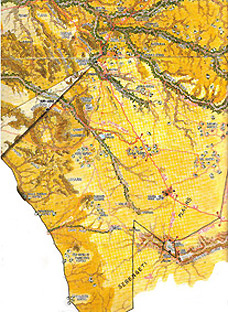 |
At the cross section of two straight lines lies Seronera Lodge with a airstrip where Seronera River flows nearby. More to the left up is the best of Serena Lodge near the fork of main roads. The left one leads towards Ndabaka Plain and on to the Lake Victoria with townships of Mwanza or Musoma. Sopa Lodge built on Niabora Hills is situated about halfway on the darker straight line and below of the Mbalageti River bed starting from below center flowing northwestwards at upper left . |
Later I returned to our group waiting at the dinning room and heard about Matthew's arrival who told "stories" about how he had spent the night in his car besieged by howling hyenas etc. Certainly, it could not be a pleasant night for him being restricted to car's limited space as he had a rather bulky body. The helpful headwaiter called by radio his office in Arusha to find out from SIMBA operator when other cars would arrive at camp TAWISA at last. The answer came soon after with the instruction that we should have a lunch in the camp and that cars would pick up us at 14h latest. So the kitchen was busy again and an improvised lunch was served within an hour. We had little time to finish eating when two more vehicles drove in so everybody got busy, luggage was quickly loaded and 15 passengers boarded the cars that were released from the muddy grip after all. It was 14h already when the convoy left camp TAWISA or exactly 24 hours after we were caught in the Serengeti's cotton soil muddy trap.
Numerous giraffes stood along the earthen road watching our convoy rushing by along a secondary earthen track of some 28 km to get onto the main gravel road some 4,5 km before on of the Park's entrance gate. At last we came into SERENGETI NATIONAL PARK through its southern NAABI HILL GATE where had to stop shortly. Endless plains stretched up to the horizon at road both sides where the tall grass of some 60-70 cm replaced the short one like drawn with a ruler. One couldn't see any zebras or gnus or even any of the antelopes as none of them would walk into such a tall grass that gives an excellent cover to the predators. Not long after we saw a group of vehicles in high grass at left of road so Matthew turned of to see what's going on there.
First he had to look for a reasonable place to cross over
deep excavated gutters at roadsides. Driving through tall grass involves
some danger too, as one cannot see holes or furrows in which an axle could
crack easily. Soon we came close enough to a group of lions resting in
deep grass with obviously full tummies. The only male relaxed few meters
apart from the three females but none of the animals cared about the commotion
around them at all. The lion or one of lioness lifted its head to view
at disturbers who were talking pictures like in frenzy and the next moment
lions were sleeping again. Matthew cautiously turned back to the main road
driving fast as possible passing by large SIMBA KOPJE (lions' kopje) when
dark clouds gathered again and it "smelled" after rain already. It got
cooler and it was rather important to reach the lodge safely during daytime
for sure.
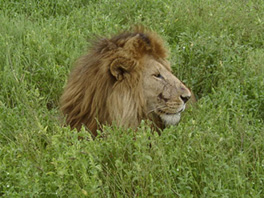 |
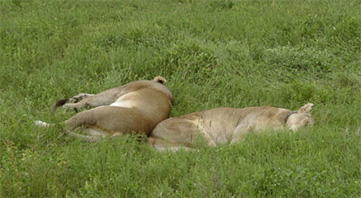 |
Some 3 km after Simba kopje the road branches of and we took the left one when a light drizzle started. That road wasn't as good as its base was of hard beaten earth so it became soft and slippery soon. The winding road ascended slowly as we bypassed Lake Magadi and crossed Mbalageti River several times. The drizzle intensified making the road more slimy particularly on steeper ascends so we "prayed" not to be caught by mud again. Road curved up with the Mbalageti riverbed at the foot of Oldoniyo Rongai hill and led up to the Niaroboro hills where SOPA SERENGETI LODGE stood at the edge of a basaltic rock. One could hardly see the outlines of its buildings due to the rainy mist in a fast coming down darkness after 6 PM. Everybody rushed to the assigned room that all had an anteroom, a large sleeping room and a bathroom inviting for an instant use. After 36+ hours staying in the same clothes and in wet shoes one happily took a warm shower and I could shave of my beard after all. Due to continuing rain and deep darkness there was no point to step out on the balcony - it was rather cool too. So we joined others at a long table in a wide dinning room that was heated from a huge open fireplace.
Every of the 15 stranded passengers agreed that we must
undertake something to penalize SIMBA Tour Operator for its gross negligence
and lack of safety equipment on its vehicles. We must get appropriately
reimbursed for leaving stranded passengers in a rather uncomfortable situation
for 9 hours and a full day lost on the safari. This totally occupied my
mind so I could sleep peacefully until next morning. The morning on January
31 turned out as a most splendid one! The rising sun drew long shadows
of any kopje or hillocks scattered on the wide Serengeti's plain as far
up to the horizon where Ngorongoro and Lake Eyasi mountain ranges rose
out of morning haze. Stepping out on the balcony I shivered of the chilly
air where loud birds' chirping rose into a cloudless blue sky. What a moment
of splendor! On the way to dinning room one could recognize the lodge perfect
setup and its beautiful and decorative interior. From everywhere one views
on a garden's narrow strip beyond that and below stretches the green Serengeti's
wide-open plain.
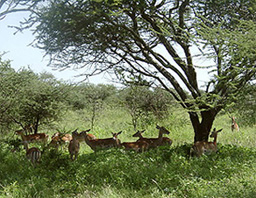 |
|
|
|
|
The Sopa Serengeti Lodge would be the best and the most
comfortable one we stayed in on our 7 day Tanzania Safari. All Sopa Lodges
solidly built using local rocky material and their exterior blends perfectly
with the surrounding. The floors polished stone slabs come from local quarries
also in large rooms that mostly have an anteroom and bathrooms are equipped
to good standard too. The internal decorations consist of quality plaster
"sgraffitis", cotton "batik" wall paintings and woodcarvings showing animals
and Masai life scenes and people. Everywhere the gardens' ground was very
well looked after and "Angel trumpet" bushes blossomed in white, yellow
or pink color at many places. We were so sorry to leave this lodge after
half-a-day instead staying here for two nights as envisaged by the safari
program.
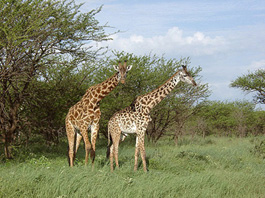 |
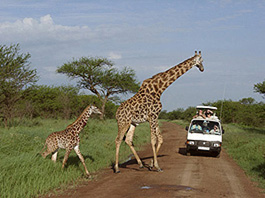 |
Matthew wanted to make good the lost day so we started
at 8h descending the same road we came in yesterday. Now the road was dry
and the countryside look just fine driving between low forest's patches
and shrubbery. Here and there we stopped to let pass groups of giraffes
or antelopes crossed our path in long strides and jumps to fast to take
any pictures. Giraffes behaved better by pausing and looked calmly at the
intruders enabling them to make perfect photos. At a road junction Matthew
turned left onto the main road leading northwards to the central part of
Serengeti NP. After 21 km drive we reached Rivers Seronera and Wandamu
where small dams create pools in which hippos find a perfect place to roam
around verdant green meadows and thickets. Damming up the two rivers also
provides watering places to various animals all year round. In deep shadow
of a tree a "chui" (leopard) was resting settled between forked branches
high above ground.
|
|
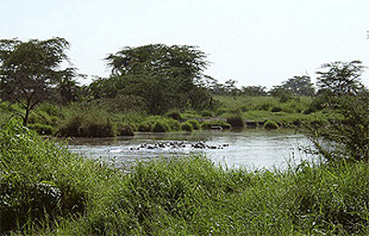 |
There are several circuits along banks and basins one
could investigate provided one has enough time to spare for animal watching.
In hurry we bypassed the nicely renovated Seronera Lodge (we stayed here
36 years ago!) and the adjacent Housing estate of Frankfurt Wildlife Society.
The guests arriving by air land on an airstrip from where some proceed
to the most luxurious Serena Lodge built on top of a kopje some 5 km away.
After a short stop at Seronera Resthouse but had to leave soon after 11h
as the next night stay over was far away.
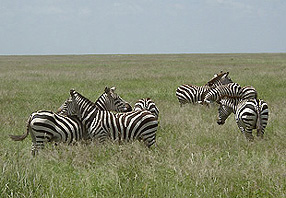 |
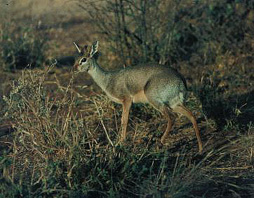 |
On the return journey we saw troupes of baboons and large
groups of impalas or other antelopes but as the day heat increased animals
gradually disappeared. Matthew kept driving at the maximum allowed speed
of 50 km/h but slowed down short of Simba kopje as a large number of zebras
stayed on the road or close to it because of too tall grass on the plain.
Zebras stood in pairs or in-groups of three or more supporting their necks
on neighbor's one. The explanation for their behavior was simple: they
could watch in two or more directions to view an encroaching predator to
be alarmed on time. Later back to Naabi Hill gate we stopped for a brief
picnic out of lunch boxes. This was to be the last of our "out-of-box"
lunch.
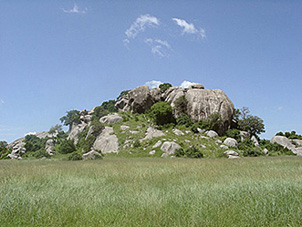 |
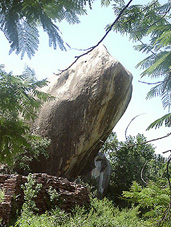 |
We left the gate around 13h driving fast passing by the
place where we turned into black cotton soil plains. At Olduvai River crossing
two Masai men after bath smeared their naked body with ocher soil. Later
Matthew stopped for a moment to distribute snacks and remnants from our
lunch boxes to children waiting en route before driving up the Ngorongoro
crater western road. At the T-junction he turned right descending the eastern
road to arrive at Loduare gate without stopping around 16h. The descend
was fast passing by Keratu village when a heat wave hit us full blast as
we were approaching the Lake Manyara region. Fellow passengers decided
to postpone the programmed visit to the Park for the next day that tired
Matthew gladly accepted driving some 200 km this day. Matthew turned left
onto an earthen road short of the steep descend to the lake itself and
we arrive to LAKE MANYARA SERENA LODGE soon after 17h.
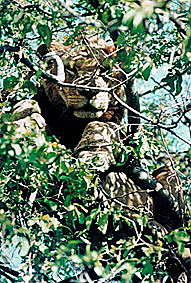 |
|
| The attraction of Lake Manyara Park were before the Tree lions. Photo made during our visit in 1965. | The happy passengers with Matthew as driver cum guide leaving the Serengeti National Park at the Naabi Hill Park Gate |
LAKE MANYARA NATIONAL PARK - Last to visit on going back to the Coast
Once we got to our room at the ground floor of a round
building ("round-a-well") we instantly appreciated the coolness experienced
during the past days. There was another annoyance that had to be dealt
with - the mosquitoes. We smeared on Autan repellent cream and put a tablet
onto electric grill being well prepared for such eventualities on a safari.
In this lodge the accommodation was simpler than in Sopa lodges previously
but still of reasonable standard. Meals were just fine prepared and served
in a nicely arranged dining room or on an adjoining balcony. During fine
dinner our fellow travelers complained about beastly mosquitoes' bites
for which they weren't ready to take.
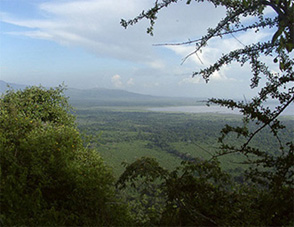 |
View on the northern shore of Lake Manyara from Sopa Lodge's lookout. At the picture center is the wooded part of Lake Manyara National Park. |
The lodge overlooks the Lake Manyara and its adjacent
swamps. It was constructed close to the edge of an almost vertical rock
some 250m above the lake waters. The fresh water for lodge's supplies is
propelled up from a spring at rock's foot. This rocky ridge is actually
part of the eastern Rift Valley dividing wall. It was in 1965 when we visited
the LAKE MANYARA NATIONAL PARK last time and stayed in Lake Manyara Lodge
next to the lake itself that is closed for foreigners now. Again we had
to get up early as usual on this safari and left Seronera Lodge at 8h for
a tour of some 3 hours.
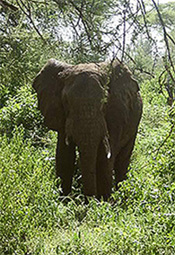 |
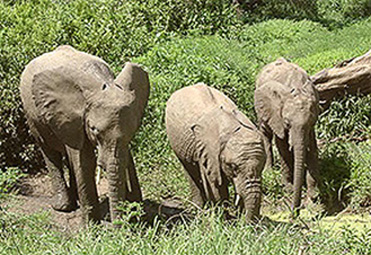 |
In recent years the park area has been considerably enlarged
southwards beyond the forested area and where lake overflows its shoreline
often. Matthew cruised slowly around park's narrow sandy tracks so luckily
we have seen many animals at close range for taking perfect pictures. A
large troupe of baboons roamed through wild mango trees, played and chased
around until a large male ordered to proceed deeper into the forest. There
were smaller herds of giraffes, gazelles, water bucks and elephants old
and young ones to your choice to make best of pictures. However we haven't
seen the famous Manyara "tree lions" that scared me profoundly on my last
visit here to take photos and stuck out my head through the roof of ranger's
car who drove us around.
|
|
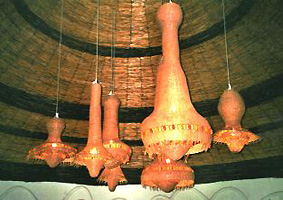 |
Returning to Serena lodge we had a fine lunch and departed
at 14h onto the return journey stopping at Mto Wa Mbu where Matthew collected
a bag of "posho" flour (of white maize). After 1,5 hour of gruesome shaking
on a very rutted and rough road (BEWARE of 77 km on B144!) we reached the
tarmac road at Makayuni at last. The 50 km drive on tarmac couldn't stop
our body's "internal vibration" caused by that hideous 77 km road stretch
of before. Matthew drove us straight into ARUSHA and we arrived at NOVOTEL
MT. MERU at 17h for the last overnight stop. During the 7-day safari we
were in good Matthew's hands who was our driver cum guide driving his vehicle
some 1.050 km including Serengeti's "black cotton" mire.
NOVOTEL MT. MERU IN ARUSHA - An overnight stay only
The room reminded me of the former "socialistic" hotel designs all named "Novotel" during my professional years. Also I had some doubt about the management that was French as found out later. Furniture was simple but worn out and the bathroom would badly need some renovation too. When we got towels and the "running" WC was fixed a little bit we decided to shower and changing in fresh cloth went down for dinner. There a stern looking Maitre d' met us at the dinning room where the staff looked dull and somehow distant to their guest. There was no smiling or a respected look of welcome to the visitor that's so typical for Kenyan waiters. One told us that most of staff members are local Masais and they are too pride to serve anybody even the tourists. I would say that this is more the way of thinking learned during times of the "African Socialism" lasting some 30+ years.
The Republic of Tanganyika got independent in 1961 and its president Julius Nyerere "Mwulimu" (= "Teacher") choose for to remain a member of the Commonwealth. The revolution in Zanzibar dethroned the Sultan and the island declared its independence in 1963. The two countries united in the new state named REPUBLIC OF TANZANIA. At those times Marxism was en vogue and Nyerere introduced the "African socialism" as his political notion and nationalized foreign banks, insurance, import & export companies, commerce and industrial corporations early of 1967. Consequently commerce, trades and marketing collapsed thus ruining the national economy of the fledgling state. Mwulimu requested the peoples to abandon their traditional rural life and tribal or clan societies and move into new government settlements where they would benefit all the advantages of an African socialistic society. Recently the new government tends to attract foreign investors and funds trying to introduce the free market and the private property in the Republic of Tanzania. However changes and results may come rather slowly as starting a new economy and setting up a new infrastructure would take many years to accomplish. The same applies to the tourist trade for which good roads and proper accommodation facilities are essential particularly to the more requesting visitors now days.
The 15 "sufferers" met after a not exciting dinner and I explain that we should lodge a claim to our Travel agents. It should cover the loss of one safari day caused by SIMBA TOUR operator's gross negligence running the 7-day safari tour. My "obsession" subsided and I slept well despite bad feelings about "traces" of former socialism around. We received a most adequate reimbursement from our Travel agents a week later. On Friday February 2, 2001 we had to get up early (for the last time!) to arrive to Arusha local airport at 09:30. An hour later we boarded a smaller aircraft "COUCH" on the return flight that followed the same procedure as on arrival a week ago. Disembarking at Mombasa two hours later were back to our hotels around 14h. Luckily we found some lunch leftovers but no seas at all as it was low tide. Perspired and tired we moved to an another room starting to unpack having swimming trunks on only. By Jove, it was so hot and humid! Just don't worry! Your are back to the Coast and in a few hours you'd have a long swim in warm seas at last.
*** End of Part 2/2 ***